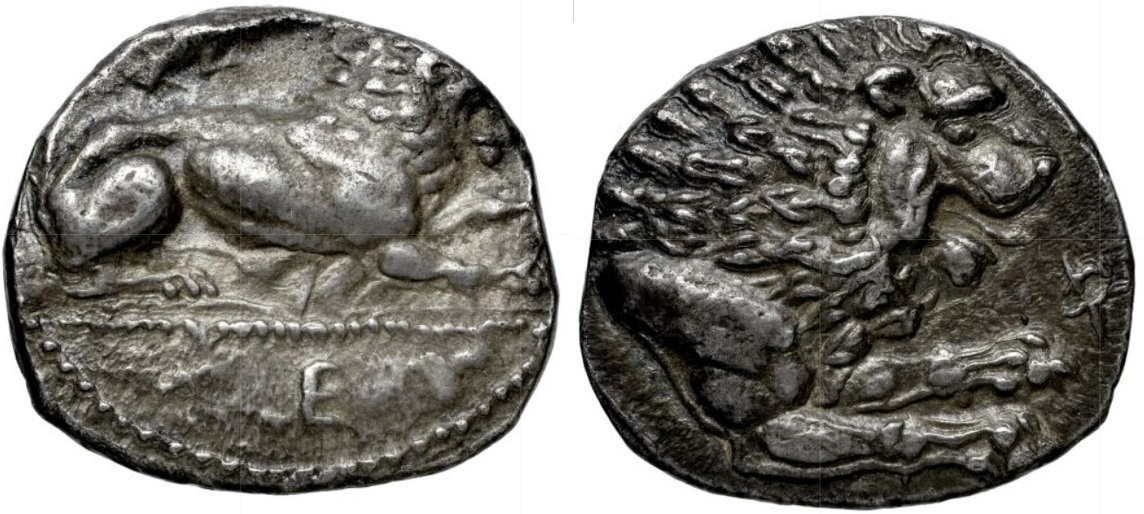S 1583 - Amathus (Evagoras I), silver, staters (391-386 BCE)
From SILVER
391 BCE - 386 BCE Silver 140 kg
Description
| ObverseInscription or printing placed on the obverse.: | Lion reclining right, paw raised, above eagle flying right (E in ex.) |
| ReverseInscription or printing placed on the reverse.: | Forepart of roaring lion right |
Mint and issuing power
| MintIdentifies the place of manufacture or issue of a numismatic object.: | Amathus | Ancient regionAncient region.: | Cyprus | Modern countryModern country: Greece | AuthorityIdentifies the issuing power. The authority can be "pretended" when the name or the portrait of X is on the coin but he/she was not the issuing power. It can also be "uncertain" when there is no mention of X on the coin but he/she was the issuing power according to the historical sources: | Evagoras I (king of Salamis, 411-374 BC) |
Chronology
| FromIdentifies the initial date in a range assigned in a numismatic context. | 391 BCE | toIdentifies the final date in a range assigned in a numismatic context.. | 386 BCE | PeriodTime period of the numismatic object.: Classical 480-323 BC |
Physical description
| MetalThe physical material (usually metal) from which an object is made.: | Silver |
Median weightMedian of the weights of numismatic objects (in grams). in grams | 6.50 | DenominationTerm indicating the value of a numismatic object. Examples: tetradrachm, chalkous, denarius.: | stater |
StandardStandard.: | Rhodian |
Image

S1583 Amathus Evagoras.jpg [1]
References
| Die study referencePublication of the study: | Amandry 19841Amandry 1984, p. 70, n° 127 | ||
| Coin series referenceReference to coin series study: | BMC Cyprus2BMC Cyprus, Amathus, n° 7-8 | ||
| Coin series web referenceCoin series web references: | |||
Obverse dies distribution
| FrequencyFrequency of specimen in distribution. ᵖ | Number of obversesNumber of obverse dies. ᵖ (o) | % (o) | Number of coinsNumber of coins. (n) | % (n) | Die nameName(s) of the die(s). |
| 6 | 1 | 100 | 6 | 100 | 1 |
| Total | 1 of 1 | 100 | 6 of 6 | 100 |
Reverse dies distribution
no distribution is available
Quantification
| Number of obversesNumber of obverse dies. ᵖ (o) | 1 | Number of singletons (o1)The number of singleton coins. ᵖ | |
| Number of reverse diesNumber of reverse dies. (r) | 3 | Number of coinsNumber of coins. (n) | 6 |
| Coins per obverse dieNumber of coins per obverse die. (n/o) | 6 | Coins per reverse dieNumber of coins per reverse die. (n/r) | 2 |
| Reverse per obverse ratioRatio of obverse dies divided by reverse dies. (r/o) | 3 | Percentage of singletons (o1)number of coins (n) divided by the number of singletons (o1) ᵖ | % |
| Original number of dies (O) (Carter 1983 formula)The estimation of the number of coins according to Carter 1983 ᵖ | 1.08 | Coins struck if 20,000 as average productivity per dieCoins made if the average productivity for obverses (according to Carter) is 20,000. ᵖ | 21,600 |
| Original number of dies (O) (Esty 2011 formula)The estimation of the number of coins according to the singleton formula in Esty 2011 ᵖ (O) | 1.2 | Survival rate if 20,000 as average productivity per dieSurvival rate if average productivity is 20,000. ᵖ | 0.00028 |
| Coverage (o = % of O) (Esty 1984 formula)Esty 1984 - coverage (% of O) ᵖ (o = % of O) | % | Die productivity if survival rate 1/2,000Average productivity if survival rate is 1/2,000. ᵖ | 11,111.11 |
| Weight of silver (in kg) if 20,000 coins per die (O = Carter formula)Carter 1983 * Median weight * 20000 (*10 if gold or electrum) ᵖ | 140 kg <br /> 140 kg | Die productivity if survival rate 1/5,000Average productivity if survival rate is 1/5,000. ᵖ | 27,777.78 |
Remarks
References
- ^ Amandry, Paris (1984), "Le monnayage d'Amathonte", in Pierre Aupert and Marie-Christine Hellmann (eds.), Amathonte I. Testimonia. 1. Auteurs anciens - Monnayage - Voyageurs Fouilles - Origines - Géographie, Etudes chypriotes 4, Paris, p. 57-76, pl. 11-20.
- ^ Hill, George Francis (1904), A Catalogue of the Greek coins in the British Museum, vol XX : Cyprus, London, cxliv, 119 p., xxvi pl.,